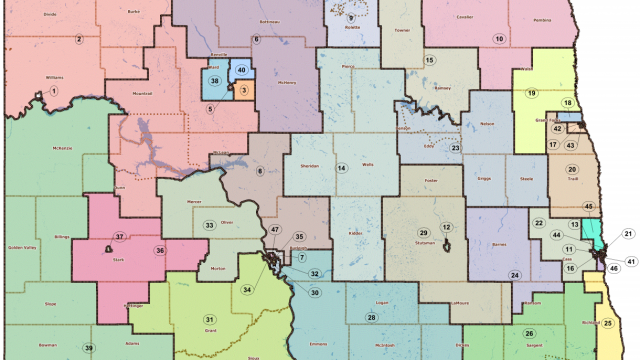North Dakota Democrats Accuse Republicans Of Gerrymandering, But Say Population Growth Will Help

“We will be a competitive political party for years to come and even more so as our population continues to grow,” Democrat Senate Minority Leader Mac Schneider said at his party’s state convention over the weekend. “There has been an effort by the supermajority in the Legislature for a partisan advantage.”
Senator Schneider is making two claims: First that population growth due to North Dakota’s oil boom will benefit Democrats, and second that Republicans have already gerrymandered the state’s legislative districts for partisan advantage.
Both claims seem about as likely as a political not on the statewide ballot in the last 26 years giving an advantage in 2014.
First, on the issue of gerrymandering, I’d point out that it’s hard to gerrymander in a state already dominated by one party. The 2010 re-drawing of lines, approved by a special session in 2011 and signed into law by Governor Jack Dalrymlpe, was “written by a Republican-controlled committee of lawmakers,” as the Associated Press artice suggests, but that was because Democrats win so few legislative elections they don’t get many seats on any committees. That’s an outcome of democracy, not partisan maneuvering.
And the lines drawn don’t seem especially beneficial to Republicans. Sure, Senator Schneider’s predecessor at Minority Leader, current Agriculture Commissioner candidate Ryan Taylor, was put into the same district with another Democrat state Senator (Taylor opted to run for Governor in 2012), but two Republicans – Senator Joe Miller and Senator Curt Olafson – were put in District 10 together by the same committee (Miller won the local NDGOP’s endorsement over Olafson), and in three other districts across the state there were surpluses of Republican House members.
Ultimately redistricting was a wash across party lines. Democrats picked up two seats in the state Senate, and Republicans picked up two seats in the state House. Hard to see gerrymandering in that.
As for population growth, it’s worth noting that most of the population of the population growth is happening in western North Dakota. Recently the US Census released a ranking of 100 counties nationally by population growth, and North Dakota had seven counties on the list. Five of those counties – Williams, Stark, Ward, Burleigh and Morton – are in central and western North Dakota where Democrats are struggling to find candidates.
In Ward (Minot) and Burleigh/Morton (Bismarck/Mandan) counties, in the center of the state, Democrats have managed to find a candidates in just two legislative districts on the ballot this year. In Stark and Williams counties Democrats have found exactly two legislative candidates so far. Of the five legislative districts representing the oil patch, Democrats have a single candidate in just three districts.
Growing populations in Grand Forks County (Grand Forks) and Cass County (Fargo) might help Democrats, but it’s likely gains in western North Dakota will offset any advantage. Particularly when you consider the demographic moving to North Dakota (which skews young and male) is from the the energy industry, a demographic that’s probably less likely to vote for Democrats.
Interesting times ahead for North Dakota in terms of shifting political winds, but I’m not sure Democrats should be as optimistic as they are. Then gain, Republicans thought growing population in western North Dakota would give Rick Berg an advantage over Heidi Heitkamp in the 2012 election, but that didn’t seem to materialize.




